Tom's Guide Verdict
With its bold design, powerful performance and innovative features, the ROG Phone is one of Asus' most compelling smartphones to date.
Pros
- +
Unique, eye-catching design
- +
Powerful performance
- +
Beautiful display
- +
Great cameras
Cons
- -
Expensive
- -
Below-average battery life
Why you can trust Tom's Guide
As games like Fortnite and PlayerUnknown's Battlegrounds continue to reign supreme on our phones, companies like Asus are betting that consumers will want a smartphone with a little more oomph to handle the influx. Enter the ROG Phone.
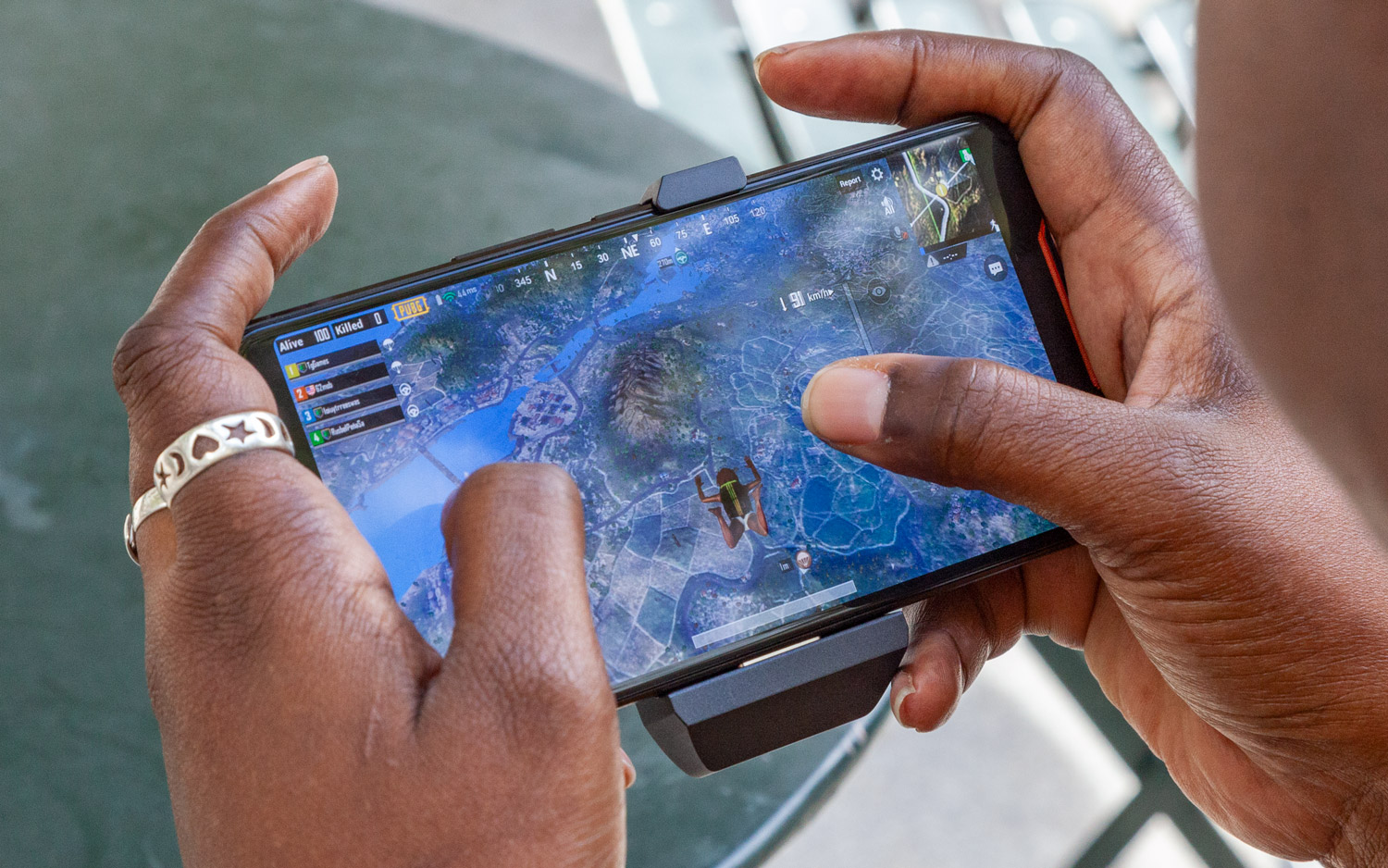
Priced at $1,099, the ROG is one of the most powerful phones on the market, thanks to its overclocked Snapdragon 845 processor. And thanks to some cleverly placed haptics and a bright, beautiful OLED display and loud audio, it's ideal for gaming or just watching a movie. I'm still not sure if the world wants or needs a dedicated gaming phone, but the ROG Phone is one of Asus' most compelling to date. See all of our top picks for best phones.
Design
The ROG Phone's design is definitely polarizing. Made from a mix of glass and metal, the mobile device is leaning into the whole "gamer phone" look. When I passed the phone around the office, my colleagues called it aggressive and over-the-top, words you'd seldom hear used to describe a smartphone. But I think the look is rather refreshing.
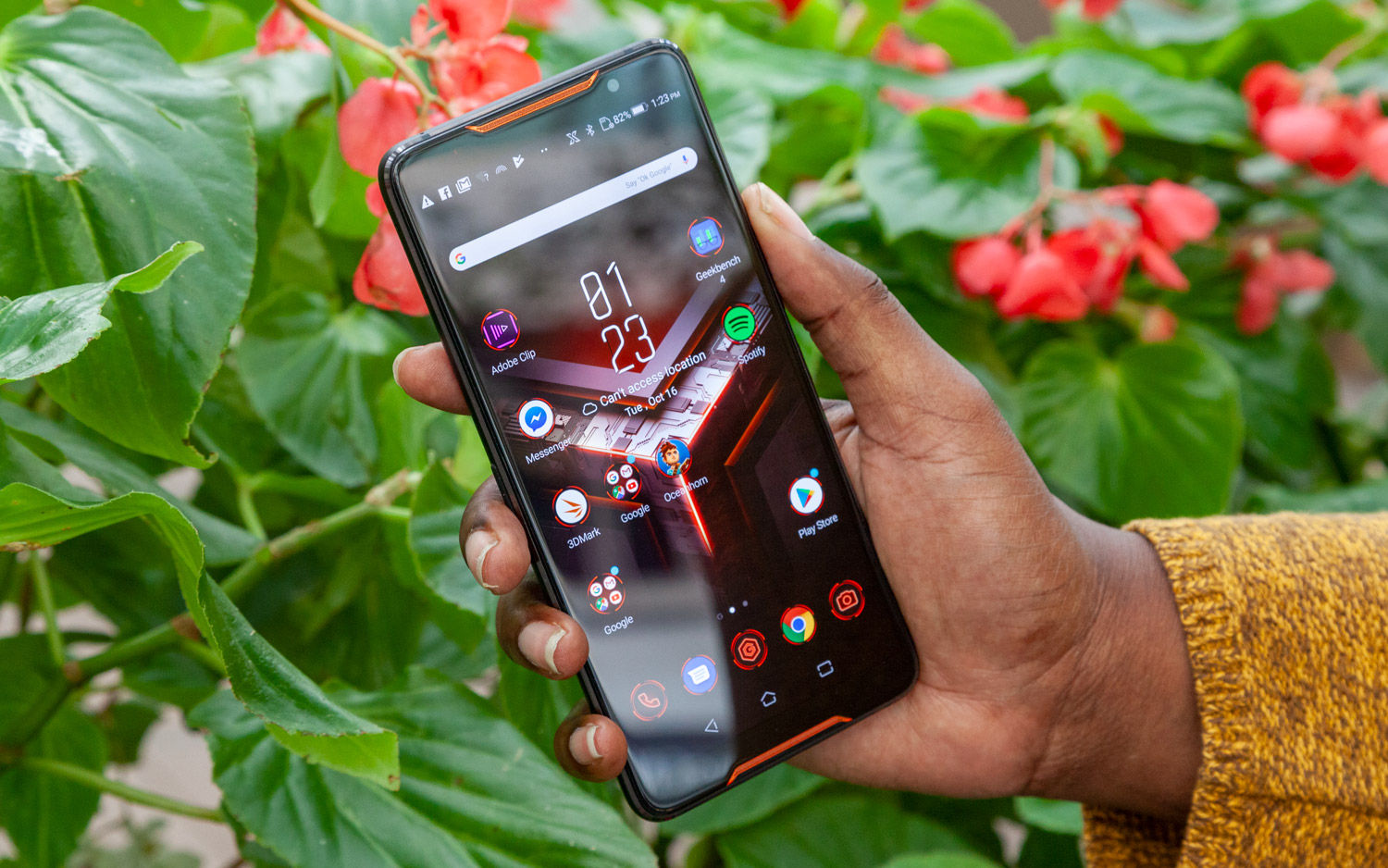
You get the first inkling that the ROG isn't like the other phones when you take a look at the front. A pair of copper accents breaks up the monotony of the black top and bottom bezels. A status light and the 8-megapixel camera sit at the top on either side of the showy accoutrement.
The next hint that this ain't your average smartphone comes when you tour the aluminum sides of the device. On the left, there's a proprietary port used to connect all the optional peripherals Asus has created to optimize your gaming experience (more on that later). But if you look a little bit closer at the special port, you'll find that it's actually two ports, one of which is USB Type-C. The reasoning behind this hidden port is pretty simple — when you're running low on power while gaming, you can connect a charger into that port without it intruding on your gameplay.
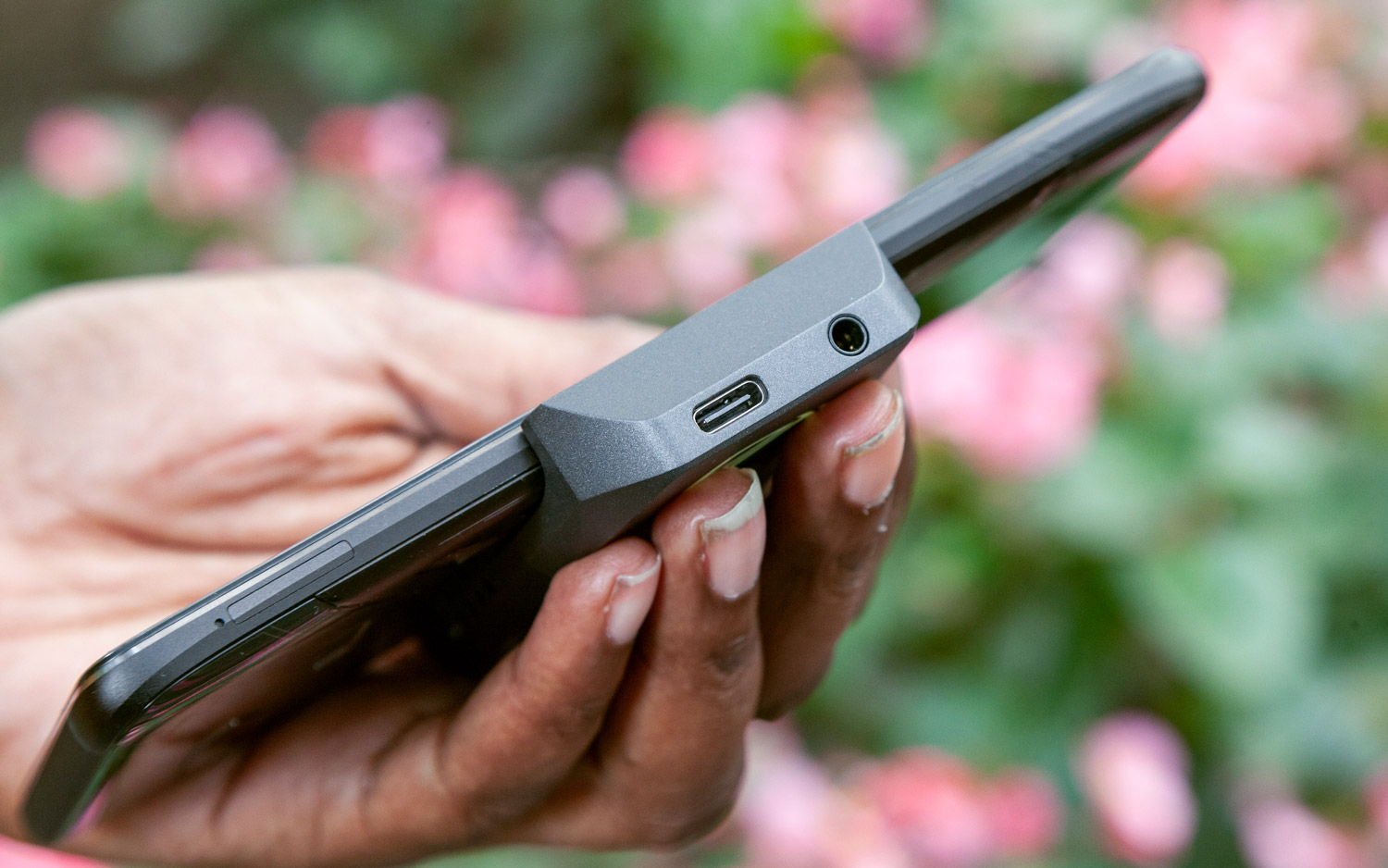
Slightly raised, the power button and volume rocker reside on the right. On the bottom, there's another USB Type-C and a 3.5 millimeter audio jack.
But the show really starts when you flip the phone over. The glossy Gorilla Glass' space-gray panel is bold and futuristic and bursting with geometric design, from the delicate silver lines at the top to the polygonal shapes housing the dual 12MP cameras. Hell, even the LED flash's casing is a funky parallelogram. Directly below is an off-center shiny polygon hiding a fingerprint scanner.
The ROG Phone's design is definitely polarizing.
The main attractions is the large backlit ROG logo, which, like any good gaming device, is customizable. The other show stopper is the ROG Aerodynamic System, which looks decidedly badass with its geometric patterns etched into the black plastic with two copper vents.
At 7.1 ounces and 6.3 x 2.9 x 0.3 inches, the ROG Phone, is by no means a small phone or a lightweight, but it's in good company. It's almost the same size as the Samsung Galaxy Note 9 (7.1 ounces, 6.3 x 3 x 0.34 inches) and a little heavier than the Google Pixel 3 XL (6.5 ounces, 6.2 x 3.0 x 0.3 inches). At 7.3 and 7.8 ounces, respectively, the Apple iPhone XS Max and the Razer Phone 2 with their 6.2 x 3.1 x 0.3-inch frames are the heaviest devices in the lineup.
All of the Lights
I'm used to programming lighting on gaming laptops, mice and headsets, but having the ability to program 16.8 million colors for the ROG logo on the back with a quad of effects is a first. The ROG Phone has Asus' Game Center preinstalled, allowing you to tweak CPU clock speed, fan speed and color. When you're ready to start customizing, you just launch Game Center and access Aura Lighting. From there, you can choose an effect (Breathing, Strobing, Static and Color Cycle); depending on your effect, you simply use the slider to pick your color. If there are other ROG Phones in the vicinity, you can sync them to flash and create a mobile light show.
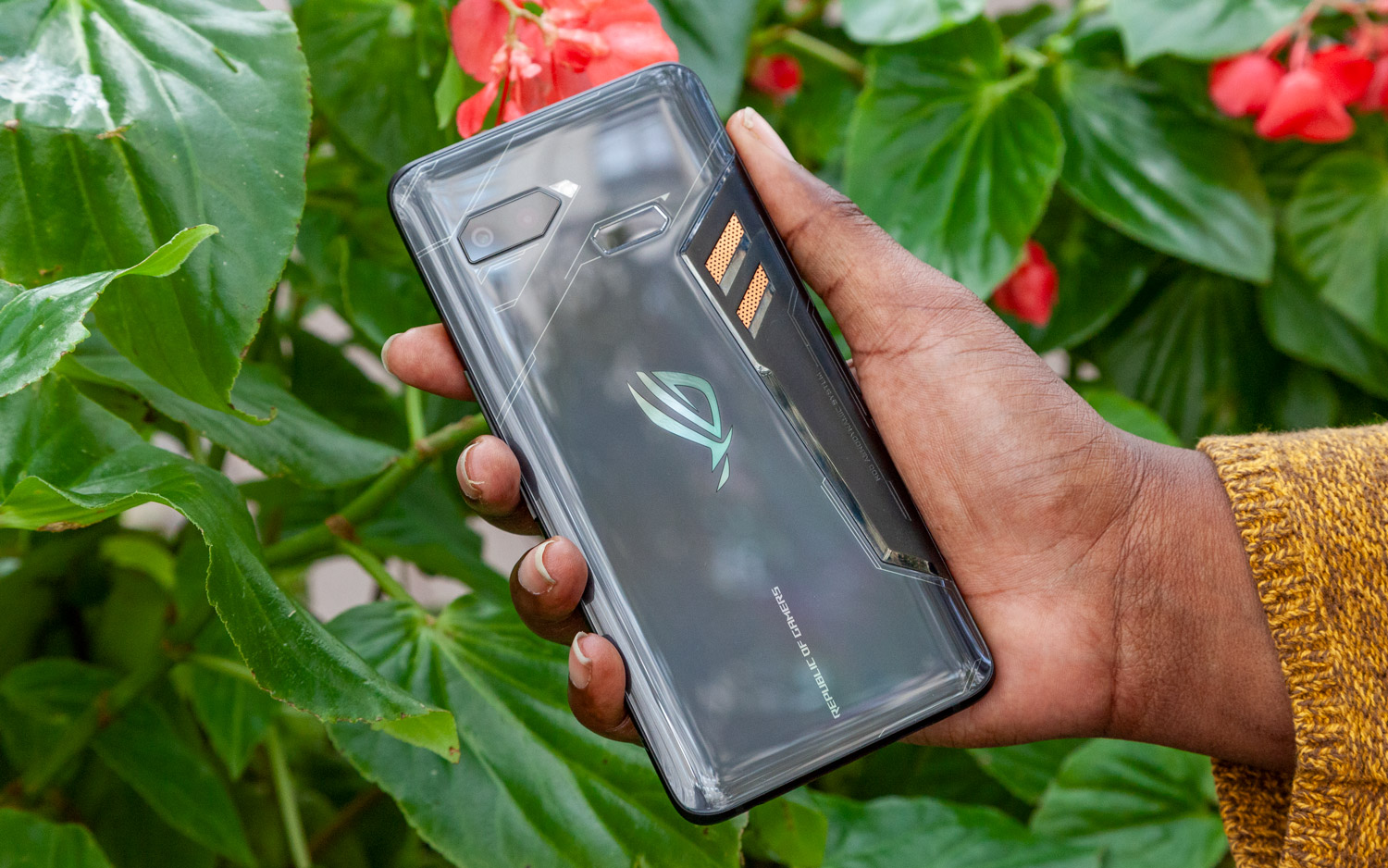
While that's pretty cool, I wish there was a bit more functionality baked into the ROG Phone's color support, similar to what Razer's done with the second iteration of the Razer Phone. Razer's Chroma feature allows you program lighting for everything from notifying you about email to signaling if you're taking damage in Fortnite.
Display
Big, beautiful color. That's what Asus is serving up with a massive 6-inch, AMOLED display that's both vivacious and, thanks to its 2160 x 1080 resolution, sharp. Thankfully, since the display is made of Corning Gorilla glass, it's as durable as it is pretty. The ROG is also the first phone to use Corning's 2.5D curved-edge glass, which the company claims can survive a drop from 3.3 feet.
I was blown away by the sheer attractiveness of the display, compared with the Razer Phone 2. In a side-by-side comparison, my colleagues agreed that not only was the ROG brighter, the color was more appealing. This immediately became apparent as we watched the trailer for If Beale Street Could Talk, and there were audible oohs and ahhs over the actress' golden and emerald blouse that accentuated her clear, brown skin. Details were sharp enough that we could see the springy coils that made up her immaculately coiffed afro.
The color cavalcade continued when I played Ark: Survival Evolved as a black and gold dilophosaur charged me. The last thing I saw before the world went dark was the dilophosaur's bright green venom that blinded me. Once it wore off, I chased after a few dodos, admiring their feathered hides before butchering one with my stone hatchet.
I was blown away by the sheer vivaciousness of the ROG Phone display compared with the Razer Phone 2.
Those bursts of color are due in part to the ROG screen's capability to reproduce 233.6 percent of the sRGB gamut. Its only close rival is the Note 9, which achieved 224 percent. The Razer Phone 2 produced only 104 percent.
For such a vivid panel, the ROG Phone is pretty color accurate with a Delta-E measurement of 0.5, which is much better than the Razer Phone 2's 1.2 (0 is the ideal.). However, the ROG Phone is not as accurate as the iPhone XS Max (0.2), the Note 9 (0.3) or the Pixel 3 XL (0.35).
Averaging 538 nits, the ROG Phone is plenty bright and luminous to be used in direct sunlight. It easily outshone the Razer Phone 2 (492 nits) and the Pixel 3 XL (362 nits), but it wasn't a match for either the Note 9 (604 nits) or the iPhone XS Max (606 nits).
MORE: The Best Phones for Gaming
And while the display is definitely pretty to look at (and it should be), there's more to the ROG Phone than meets the eye. For one, it has a 90-Hertz refresh rate, which means smoother graphics, resulting in a prettier game overall. Asus claims the screen has a 1 millisecond response time, which, in a game like Vainglory, can mean the difference between landing a killshot. It should be noted that the Razer Phone 2 display has a 120Hz refresh rate.
Audio
Last year, I declared the Razer Phone the best-sounding phone on the market. Asus is now right on its tail. I pitted the ROG Phone against the Razer Phone 2 in a sound-off and it was close — close enough that I had to call in a few colleagues to decide.
With its default audio settings, the ROG and its pair of NXP 9874 amplifiers easily filled our test lab. And if you need a further volume boost, you can switch to Outdoor mode. However, you'll lose a lot of detail due to the purposeful diffusion.
When we listened to Rihanna's "Work" on Spotify, we agreed that the bass line on both phones sounded boomy and diffused. However, thanks to the Razer Phone's Dolby Atmos software, it delivered the fuller, warmer performance, while the highs on the ROG sounded a bit tinny by comparison.
Camera
Wow. Asus just ate Razer's lunch and even put Samsung on notice. Outfitted with a pair of Sony IMX363 sensors, the ROG Phone’s dual rear-mounted 12MP cameras captured images that are both über-vivid and detailed.
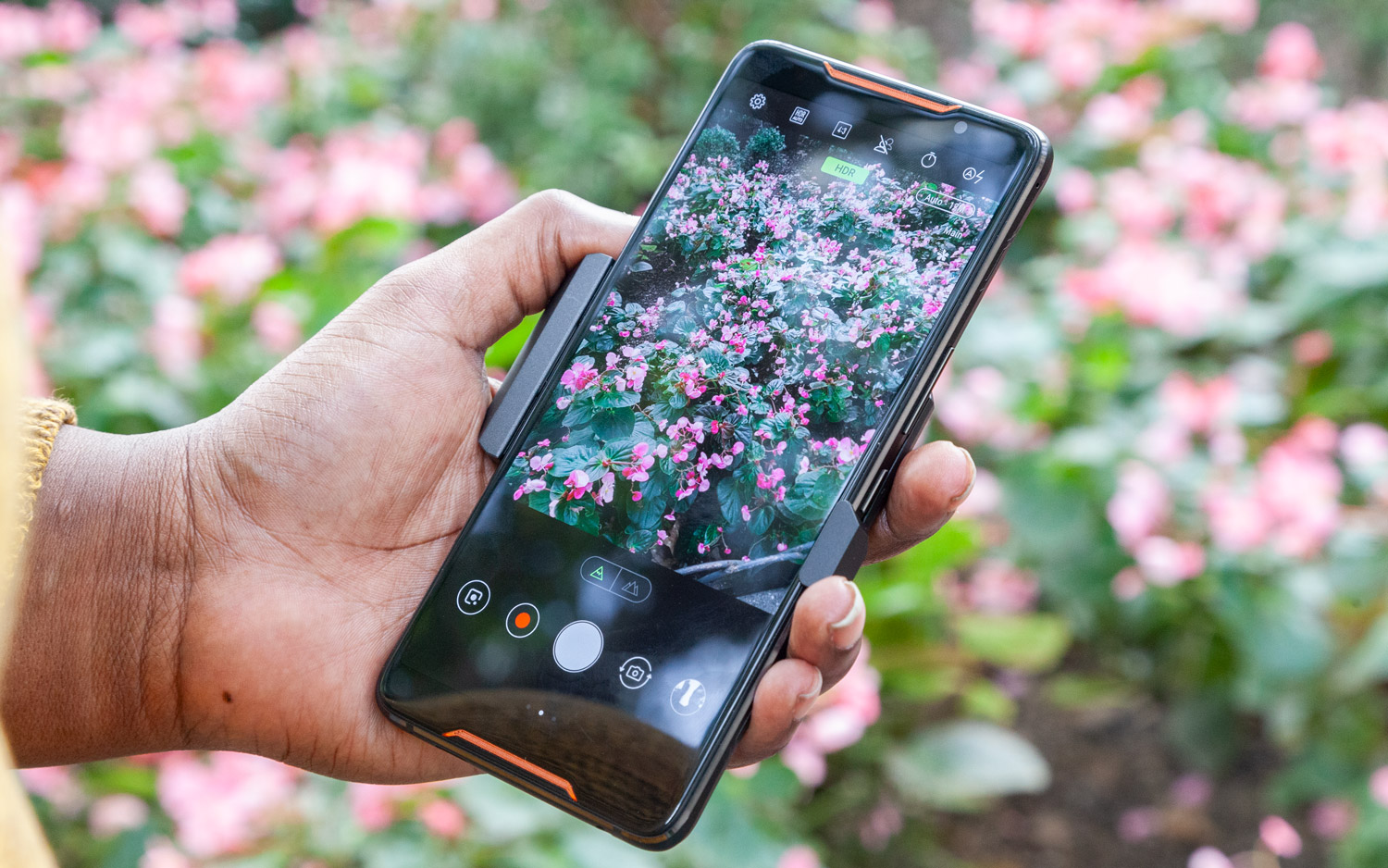
I took my first shot in our video studio and was impressed with how gorgeous Cappy, the mascot for Super Mario Odyssey, looked. The ROG's shot was on a par with the Note 9 with the richness of the reds and the golden USS Enterprise model. Regarding sharpness, the Razer had the edge, showing of more detail of the brick wall.
The ROG stumbled during my outdoor flower shoot, delivering blown-out color and lack of sharpness, particularly in the petal portion of the image. The Razer offered more detail and more accurate color, but the edges of the picture were a bit fuzzy. Although it was a bit dark, I could make out just about every vein in the actual flower petals in the Note 9's pic, and while oversaturated, several of my colleagues preferred the darker pinks.
For my low-light shot, I took Tom's Guide staffer Adam Ismail into our darkened lab. I was impressed with each camera's ability to pick up as much color and detail as they did. However, the Note 9 was the victor, delivering the most accurate skin tone as well as the best detail. Unlike the Razer, Adam's beard didn't look like it had been sketched on, and I could zoom in a few times without encountering digital noise, which is something I couldn't do with the ROG Phone.
I snapped a few selfies with each of the phones, and the ROG's 8MP shooter gave the best result. Not only did my skin tone look great, but the window in the background wasn't blown out, and you could make out more detail in my sweater.
Performance
No, the ROG Phone isn't the first to use a Qualcomm Snapdragon 845 processor with 8GB of RAM. But it's definitely one of the first to use a speed-binned CPU. Speed-binning is the process of testing identical parts to reach a certain standard. In this case, the threshold is that four of the 845's eight Kryo performance cores can run at a clock speed of 2.96-GHz simultaneously, which is notably higher than the standard 2.8-GHz. In other words, either Asus or Qualcomm tested the chips to make sure they could run and maintain overclocked speeds.
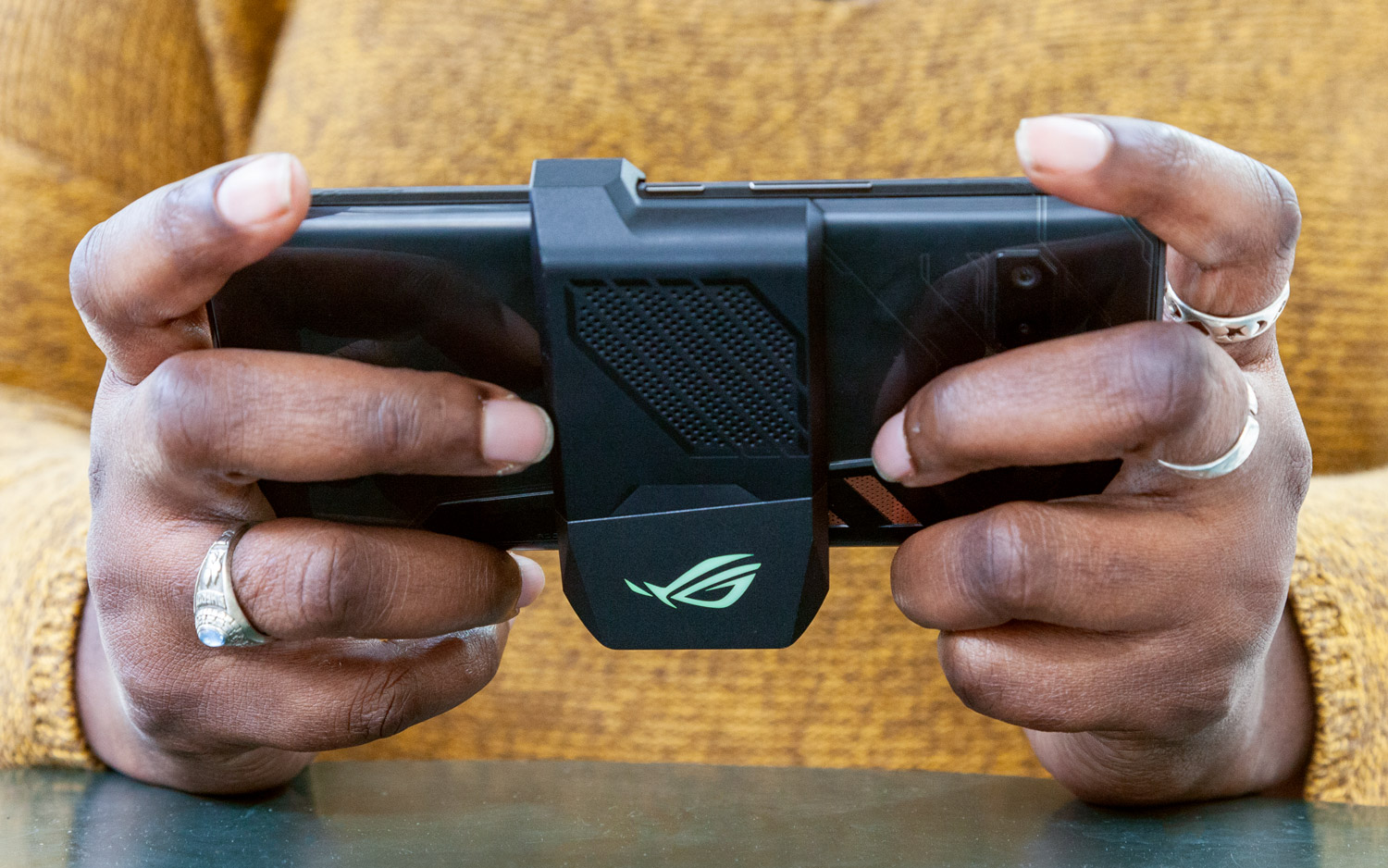
So, fancy jargon aside, what does that mean for you? Pretty powerful performance, that's what. The ROG Phone might be one of the most powerful smartphones outfitted with an 845 CPU. We ran Geekbench 4 to measure overall performance, and the ROG Phone scored 9,224. The Razer Phone 2 and the Pixel 3 XL hit 8,903 and 7,684, respectively. It's impressive, but nowhere near the XS Max's A12 Bionic processor, which scorched the competition at 11,515.
The ROG also held its own during real-world tests, taking 3 minutes and 31 seconds to transcode a 4K video to 1080p. That's faster than the Razer Phone 2 (3:59), but not enough to outpace the Pixel 3 XL (2:42) or the XS Max (0:39).
MORE: The Huawei Mate 20X Is a 7.2-Inch Monster Gaming Phone
Although overall performance is important, the ROG is a gaming phone, so it needs to deliver on the graphics front. And it does. The phone's Adreno 630 GPU managed to overtake the mighty XS Max (4,339), achieving 4,757 on the 3DMark Slingshot Extreme 3.1 benchmark. The Note 9 came the closest to matching the ROG at 4,639, but the Razer Phone 2 wasn't too far behind with 4,621. Meanwhile, the Pixel 3 XL reached 4,396.
Cooling
Remember when I said those copper-colored vents on the back of the ROG Phone were there for more than show? Well, they're a part of Asus' GameCool system. If you could open up the phone, you'd find a 3D vapor chamber along with a couple of heat spreaders and cooling pads — all so that the overclocked processor doesn't overheat causing the phone's performance to take a hit.
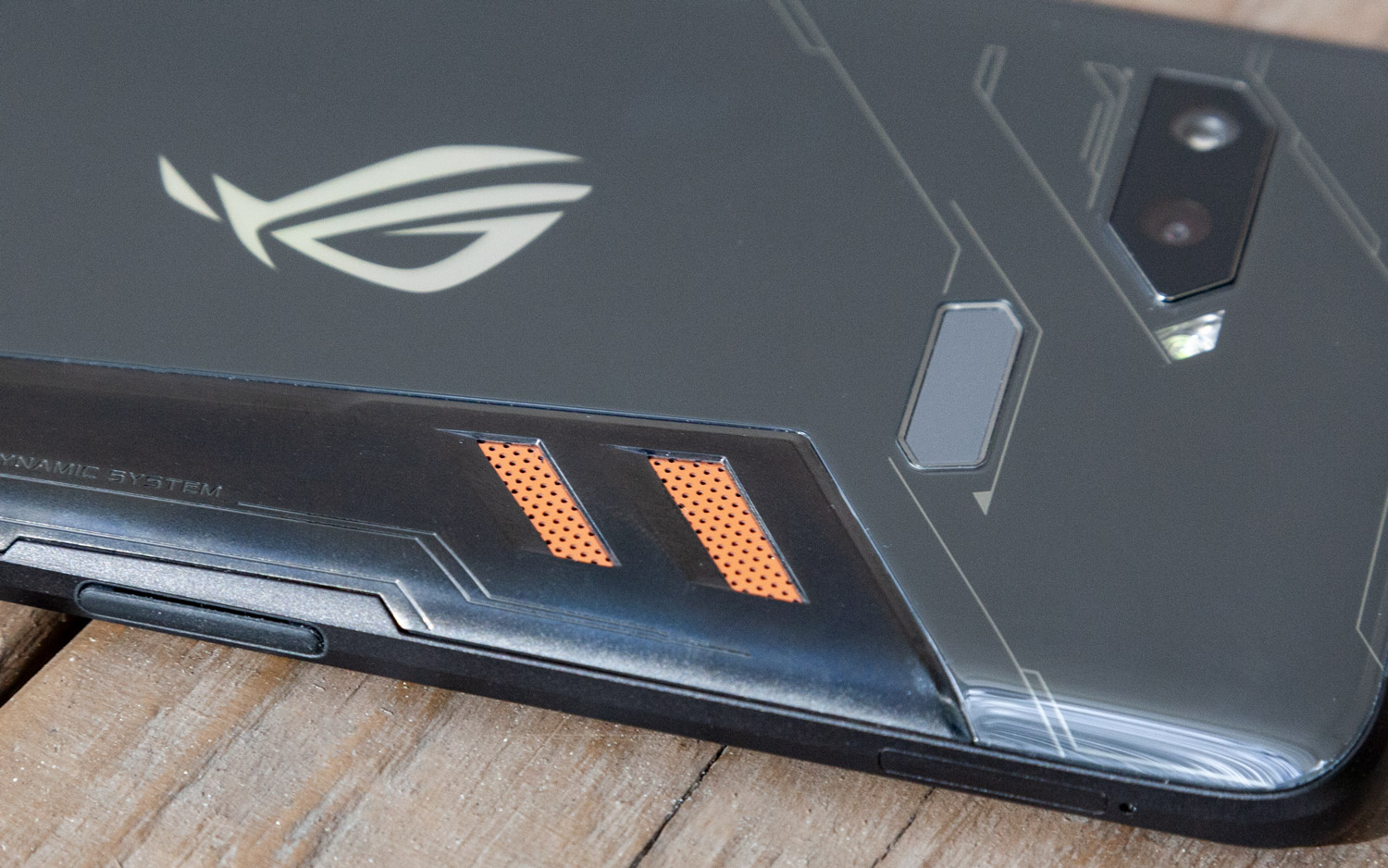
And if GameCool doesn't work, you can always attach the AeroActive cooler, which comes bundled with the ROG Phone. Once attached to the middle of the rear panel, a quick notification flashes, letting you know that the newly attached fans might interfere with the audio quality. After clicking Okay, the fans gently whir to life. If you were worried about the accessory covering all that glowing LED goodness, you can lay those fears to rest, as Asus made sure to outfit the peripheral with its own backlit logo.
MORE: Best Gaming Deals for October
I spent 20 minutes playing Shadowgun Legends sans the AeroActive cooler with the display refresh rate at 90Hz. I got a temperature of 95 degrees Fahrenheit in the middle of the logo and 100 degrees from the vents. I played for another 20 minutes and could feel the phone getting progressively warmer beneath my fingertips. When I took the temperatures this time around, the center jumped to 102 degrees while the vents hit 108 degrees.
A Gaming Phone vs. Everyone Else
So how is a so-called gaming phone different than any other high-end smartphone? The ROG is one of the few phones that has legitimate gamer-centric software. You have Asus Game Center, which is similar to what you'd find on a gaming laptop. This allows you to monitor system specs, including clock speeds and temperature. You also have the ability to adjust the Aura lighting on the rear panel and access controls for the myriad ROG Phone peripherals. And most important, this is where you access X Mode, which automatically increases the CPU clock speed and optimizes the RAM for gaming.
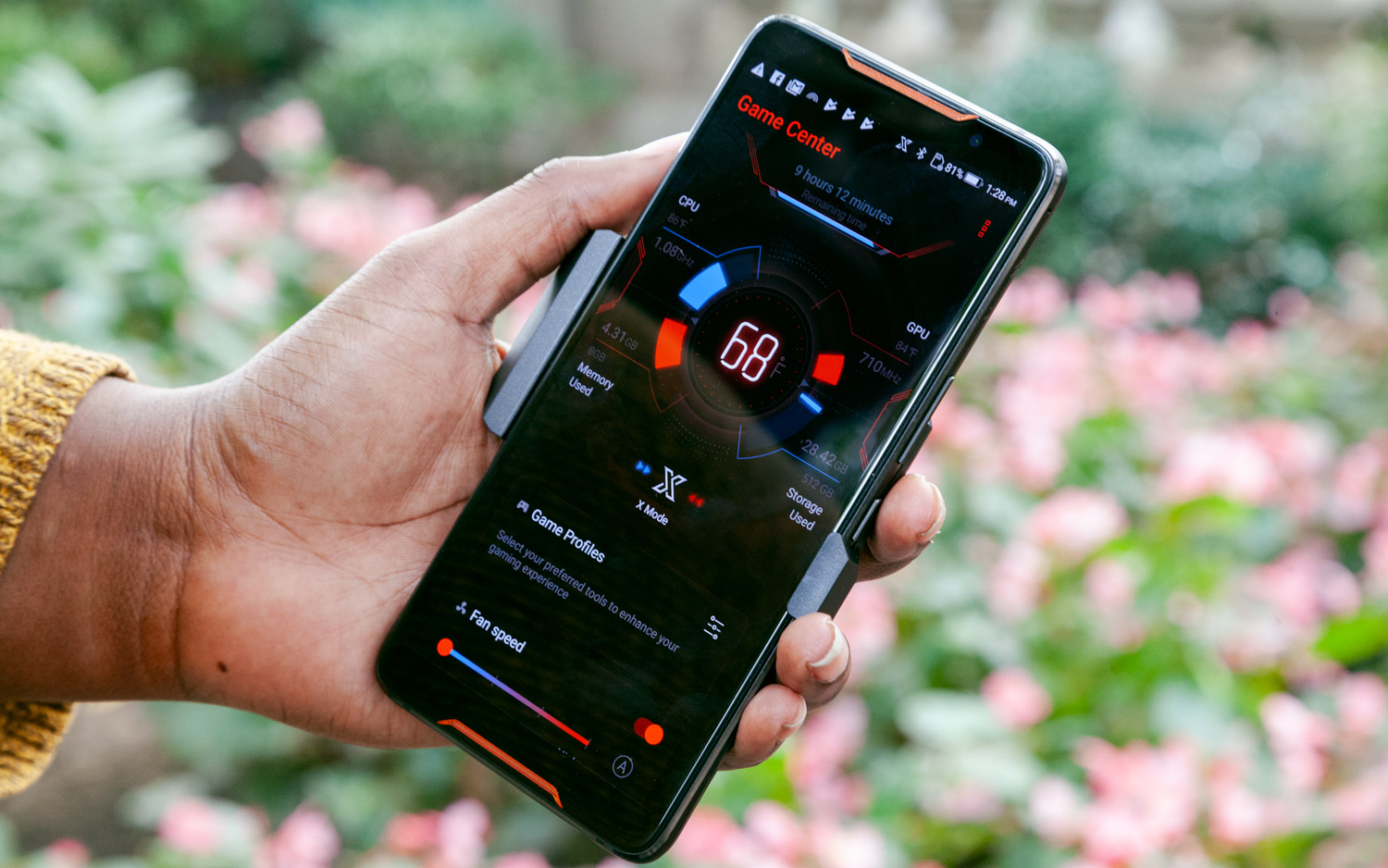
The ROG Phone also comes preinstalled with Game Genie, which lets you disable all alerts, configure the Air Triggers, map keys when you're using a mouse and keyboard andprogram macros. I also liked that I could get real-time frame rate and temperature info as I rounded curves, fought dinosaurs and explored an oceanic landscape.
Hands down, my favorite thing about the phone are the Air Triggers. Positioned along the sides of the phone when used in landscape mode, the triggers are four haptic sensors that function as shoulder buttons, similar to what you'd find on most modern game controllers. Once launched, the feature generates a red (left button) and blue (right button) sphere that can be dragged over the functionality you want to map to the shoulder buttons. For example, during PUBG Mobile, I mapped the left shoulder button to jump and the right to shoot, making it easier to gun down my foes. I made it to 31st place out of 100, which ain't too shabby for me.
I definitely appreciated the ability to map buttons to the Air Triggers, as it freed up valuable screen real estate and made playing most games easier.
When you're not gaming, the Air Triggers can be used to activate one-hand mode when the phone's locked. When unlocked, a long squeeze can activate X Mode, while a short press acts as the back button. You can also program the Triggers with a variety of actions, such as taking screenshots and launching Google Assistant or any of your installed apps.
Those additional features give the ROG a slight edge over other smartphones when it comes to gaming. I definitely appreciated the ability to map buttons to the Air Triggers, as it freed up valuable screen real estate and made playing most games easier. And while I don't imagine most gamers will use it, as a reviewer, I love having real-time performance info at my fingertips.
Battery Life
The ROG Phone is equipped with a 4,000 mAH battery, which isn't the largest battery I've seen in a phone, but it's still pretty large. (The Note 9 also comes with a 4,000 mAh power pack.) Still, I was skeptical as to how long the battery would actually last with that souped-up processor.
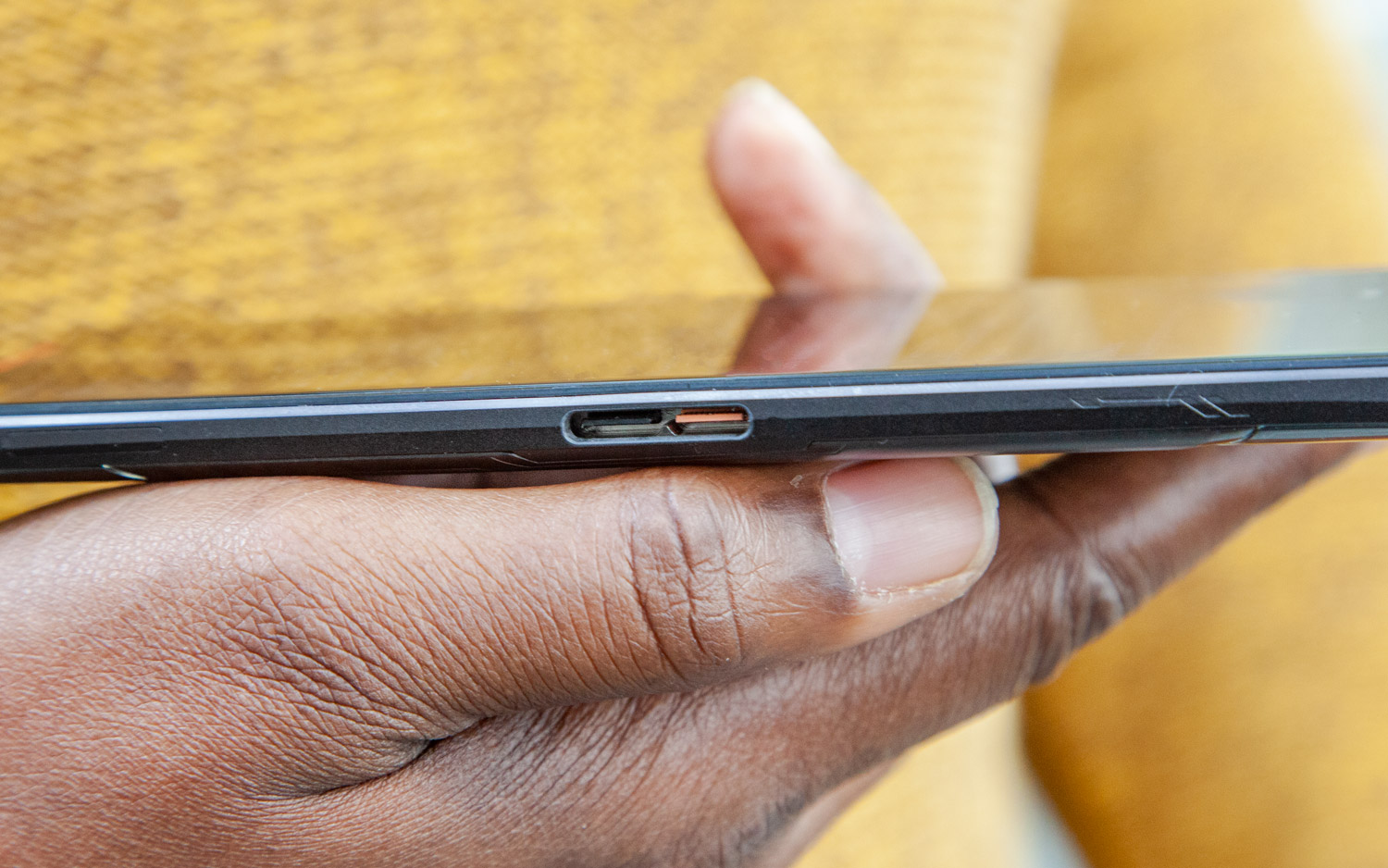
The ROG Phone lasted 8 hours and 59 minutes on the Tom's Guide battery test, which is comprised of continuous web surfing over 4G LTE (T-Mobile) at 150 nits of brightness. It's below the 9:48 smartphone average, but I was still surprised it lasted that long. Still, it was no match for the either the Pixel 3 XL (9:30), the XS Max (10:38) or the Note 9 (11:26).
But surfing the web is one thing, quite another to game. I spent 1.5hours playing various games, including Real Racing 3, Vainglory, Oceanhorn and Ark: Survival Evolved. After the allotted time had elapsed, I still had 76 percent of that massive battery life to burn through.
Zen UI
I've seen a lot of Android skins in my day, but Zen UI is so gamer it hurts (and not necessarily in a good way). I'm not a fan of the clock font or the slight outlines surrounding the circular icons, but I was still on board with the gray background with the peach tint, and I'm a fan of how Asus matched up the icon color in the notification shade with the copper accents of the actual hardware. I also like the geometric design, as it looks like a futuristic piece of a M.C. Escher drawing. And I'm not sure if anyone needs three pages of icons in the shades, but that's more of my personal preference.
Everything went wrong for me once I engaged X Mode. Once enabled, the ROG Phone goes from somewhat snazzy to obnoxious.
Everything went wrong for me once I engaged X Mode. Once enabled, the phone goes from somewhat snazzy to obnoxious. The Escher design is lit up with a reddish-pink light, which admittedly shows more detail in the design, but also looks kind of gaudy. And those subtle outlines around the icons? Now they're glowing red, pushing the whole design into garish territory. I would have been fine with the small X icon in the top nav bar instead of the unnecessary light show.
Configurations
I reviewed the $1,099 iteration of the Asus ROG Phone, which has a speed-binned Qualcomm Snapdragon 845 processor with 8GB of RAM, 512GB of onboard storage with an Adreno 630 GPU. If the thought of paying more than $1,000 for a phone, gaming or not, makes your wallet queasy, there's an $899 version that drops the storage down to 128GB. That's still a fair amount of storage, considering the entry-level iPhone XS Max costs $1,099 with only a 64GB capacity.
Accessories
Mobile gaming is convenient, but it's not for everyone. Not everyone wants to hold their phone like a game controller. Plus, touch-screen controls aren't as accurate as a traditional controller and can take up screen real estate. To that end, Asus has created a cadre of accessories, so you can play games in a variety of ways.
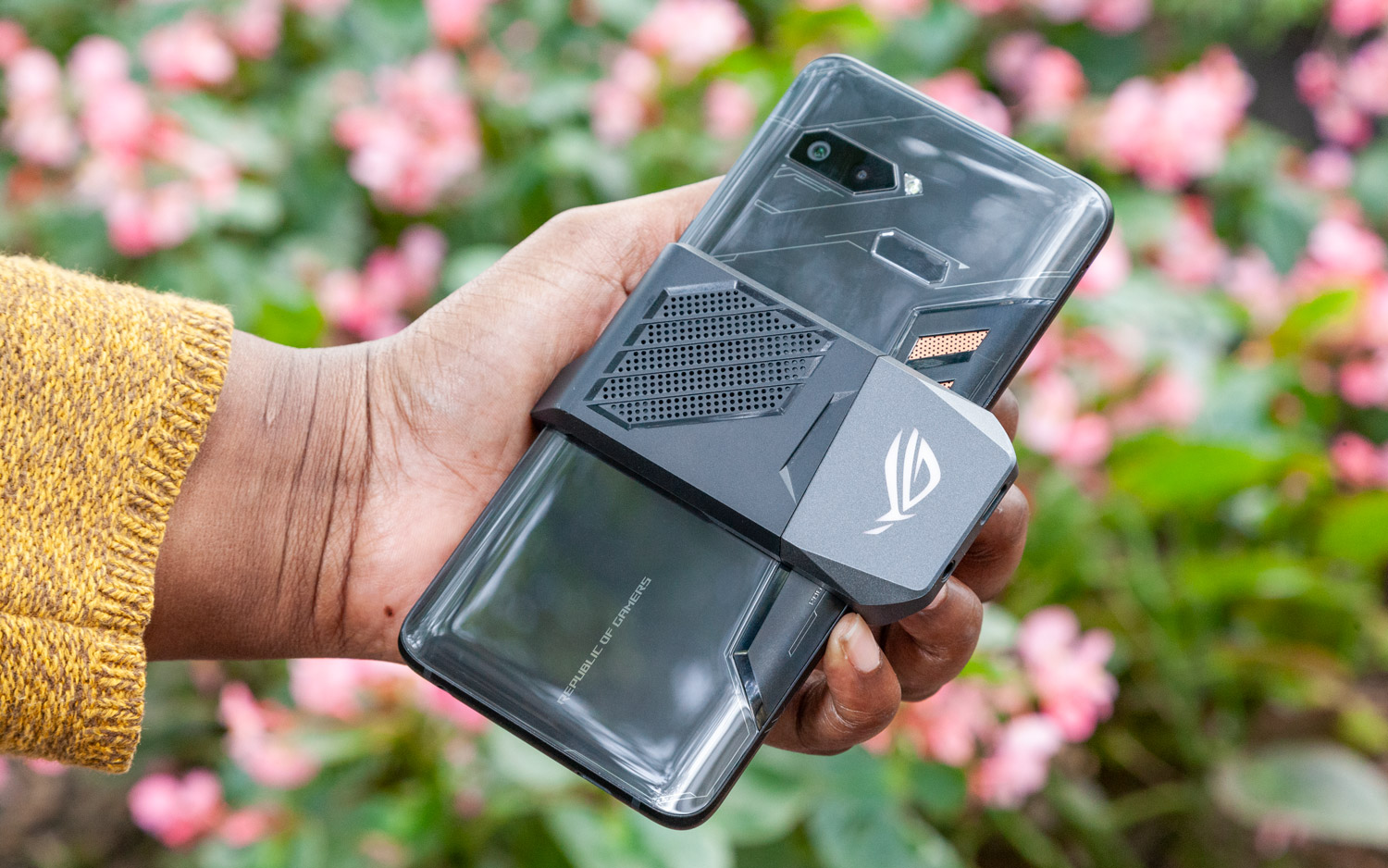
For instance, you can add a second screen to the ROG with the Twinview Dock ($399), essentially turning it into more powerful (and more expensive) Nintendo 3DS. After snapping the phone into the top half of the dock, the second, bottom-mounted 6-inch, 2160 x 1080 AMOLED display springs to life. Depending on the title, you can play on both screens, using one to navigate the world and the other to keep track of your location on the map. Or you can run a Discord chat or a livestream. When connected to the dock, the phone gains an additional 6,000-mAH battery, which will greatly extend your game time.
If you're more comfortable with a keyboard and mouse, Asus has its Mobile Desktop Dock. Starting at $229, the Desktop Dock is pretty straightforward: pop the handset in,plug in all your favorite peripherals, and start gaming. With four USB 3.1 ports, a USB Type-C port, a USB 3.0 Micro B port, an SD card reader, a Gigabit Ethernet and jacks for a mic and headphones, you can create a formidable gaming battlestation. And thanks to the HDMI, DisplayPort and DisplayPort 1.2, the dock will work with both 1080p and 4K displays.
MORE: 5 Awesome PC Gaming Gadgets to Watch
Asus also has the Professional Dock ($119) for folks looking for a more simple setup. The portable version of the Desktop Dock is a small black box that has only a pair of USB 3.0 ports, a USB Type-C port and an HDMI.
If you'd rather not futz around with having to plug in a bunch of wires into either the Desktop or the Professional Dock, you can always stream. Asus partnered with peripheral-maker Gamevice to create a specialized controller ($89) that works with a WiGig Display Dock ($329) so you can stream content with little to no latency. Asus claims the Display Dock boasts latency as low as 20ms. You have to place the phone into a controller shell, but that shell offers dual analog sticks, a D-pad and the usual face buttons.
Bottom Line
From its bold design, seriously lovely display and impressive performance, the Asus ROG Phone is a bonafide discussion starter. And the topic of said discussion: Does the world need a gaming phone?
After spending a week with the ROG, I'm still on the fence. As one of those gaudy "hard-core" gamers the company is targeting, there's so much to like about this handset, particularly the speed-binned processor and the incredibly vibrant display. And Asus really took me by surprise with how great the camera on the ROG Phone is.
However, when you're asking for $1,099, I would expect better battery life, gaming phone or not. Judging by my colleagues' reaction, not everyone is feeling the design. And after shelling out around $1,000 for a phone, I don't envision too many people forking out even more money for the accessories, especially not for mobile games. Overall, though, the Asus ROG Phone is a great first step into an burgeoning category.
Credit: Tom's Guide
Sherri L. Smith has been cranking out product reviews for Laptopmag.com since 2011. In that time, she's reviewed more than her share of laptops, tablets, smartphones and everything in between. The resident gamer and audio junkie, Sherri was previously a managing editor for Black Web 2.0 and contributed to BET.Com and Popgadget.

